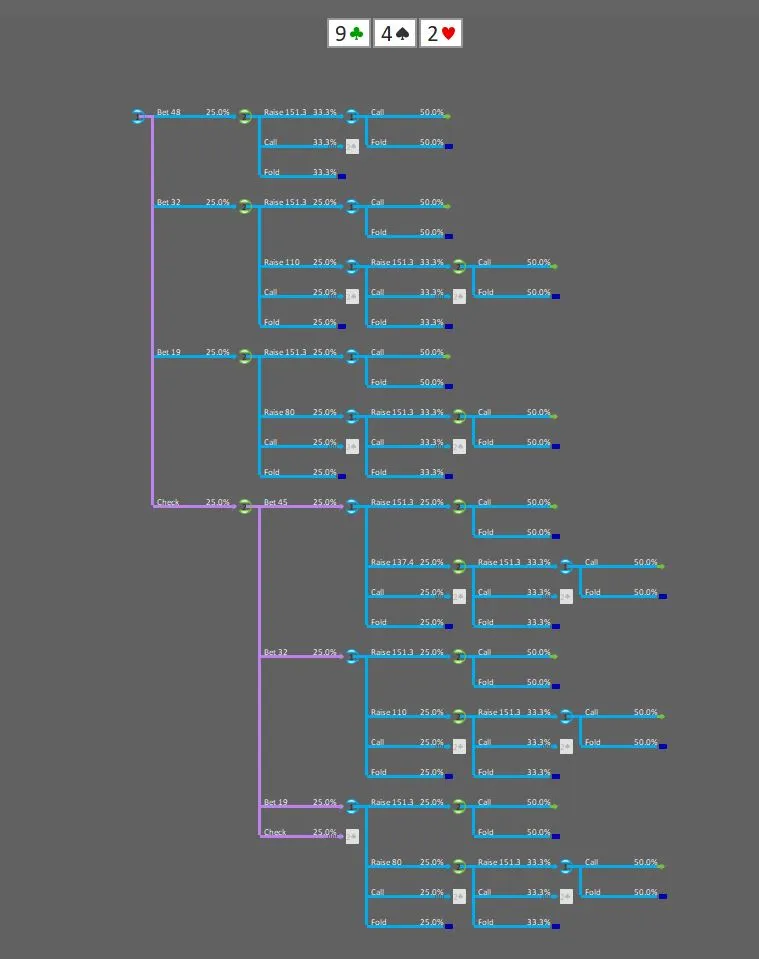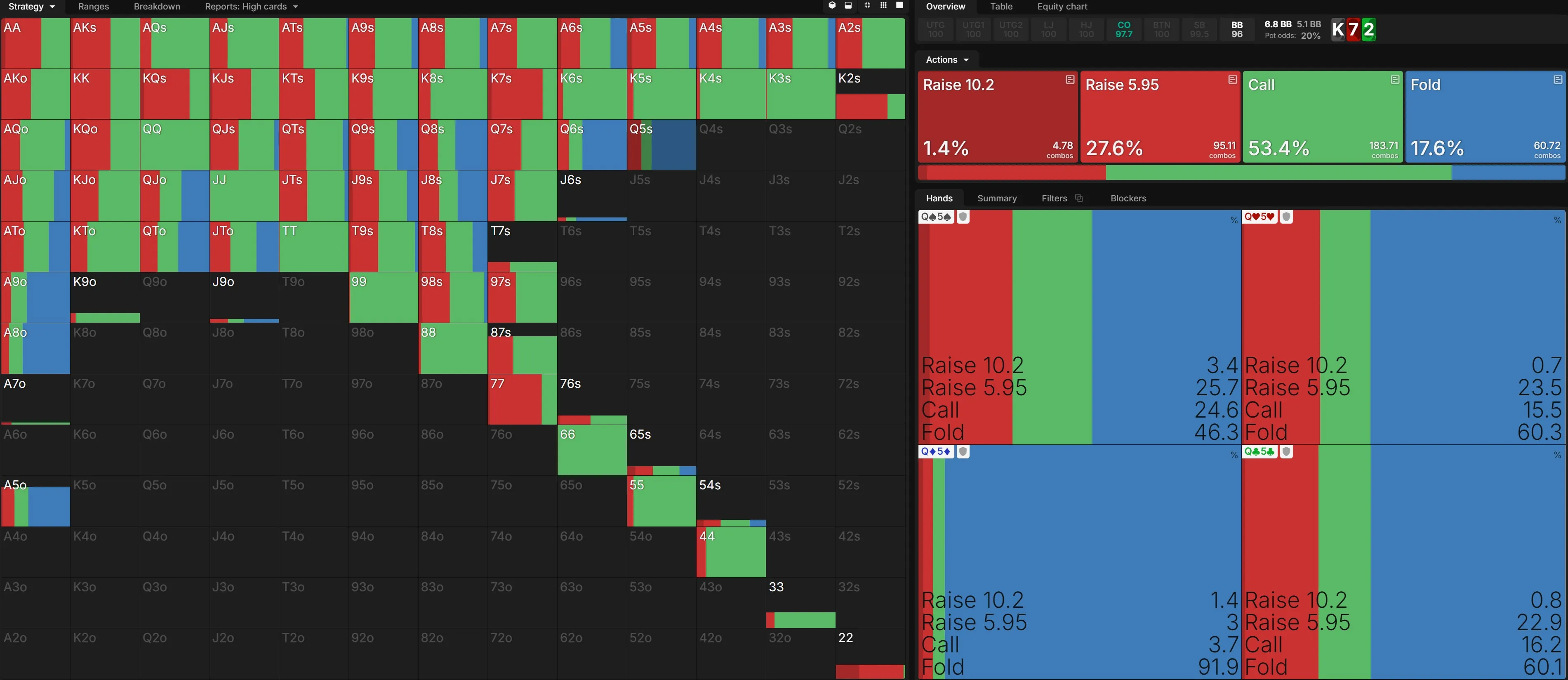GTO Poker: Decoding the Game Theory Under the Hood

Feb 18, 2025
•
2 min read
A GTO strategy is completely unbeatable regardless of the opposing counter-strategy.
- Doug Polk
What Is GTO Poker?
Expecting profit from poker implies understanding it’s a game of skill, not luck. Behind that skill lies a strategy mathematically backed by a Nash equilibrium, or a calculated solution to this zero-sum game.
Poker players refer to this solution, or rather solutions, as GTO, or game theory optimal. So…
How Is GTO Calculated?
The math behind games where one’s win stems from another’s loss dictates at least one solution or strategy exists that cannot be taken advantage of. Any other strategy opens itself to exploitation, yielding an outcome worse than sticking to the equilibrium solve.
Let’s get an intuitive grasp with a simple zero-sum game, rock-paper-scissors. The Nash equilibrium simply says to randomly draw whatever. That way, each of the three options gets thrown 1/3 of the time in an unpredictable order.
Measuring our expectation in plain math where +1 represent a win, -1 a loss, and 0 a draw:

The equation checks out since we’ll end up randomly winning as often as we tie and lose. Moreover, there’s no strategy that can perform any better.
The counters are easy to see. If you spot a pattern, you’ll know when to throw the winning hand. If they pick rock more often, relentlessly pick paper. Poker players call this exploitation.
Visualize a Poker Hand Like a Decision Tree
Poker’s much more complex. There are many decisions made in sequence, not a single decision made simultaneously by all players. We model poker using a decision tree. It starts at preflop and every decision we can make forms a separate branch.

Folding your cards makes one branch, calling the big blind another. Every raise amount you can make from 2 big blinds up to all-in has a branch all to itself. The ends of those branches form new decision points called nodes where new branches sprout on the flop, until the river or when the decisions leave all chips committed.
Take a second to appreciate this complexity. Each branch representing each decision has an expected value (EV) associated with it. That is the precise number of chips or big blinds won or lost because of the decision.
In isolation, EV isn’t hard to crunch. For example, this is the EV of one decision, calling a bet:

What complicates the math in figuring out the overall EV over a series of decisions that make a complete hand is accounting for all the branches’ EV in proportion to the frequency those branches get traveled.
How Do Poker Solvers Work?
Solvers reveal GTO poker strategy by calculating those EVs through brute force. Firstly, they limit the available branches by only modeling a handful of bet sizes at each node. Then, they pit range against range and measure EV in trial & error matches.
For example, a post-flop solver like PIO has you input starting stacks between two players as well as their preflop ranges. It’ll pick a random strategy at first, like telling first to act to bet all hands in range and the second player to always fold.
The solver then adds up the EV each hand in that range has a result of that decision and measure the difference between the loss and gain of the two players. It’ll then pick a different strategy, like having player two call half the time and fold the other times.
It’ll measure the EV difference, and if it’s less, it assumes the new strategy is better and keeps trying different strategies and measuring EV differences until it cannot improve. At that point, when no further exploits are found, we’re left with a Nash Equilibrium.
Do this across all possible flops, turns, and rivers and you have a solution set of a GTO poker strategy, at least for the SPR and game tree modeled in the starting conditions.
Keep going if you’re now asking, “what are GTO charts?”
Solver Outputs: GTO Charts
GTO charts visualize the perfect strategy. They lay out all possible holdings in a square grid. Pocket pairs divide the chart diagonally leaving suited combinations up top and off-suit combos on bottom. Color codes tell us what action to take with a particular combo.
These charts show how to split our range across all decision points to remain “balanced.” Balance keeps opponents from finding counters to our strategy, like throwing paper when an opponent overdoes rock in our simple game example.

In poker, overdoing things makes your hand easy to read. If you know when your competition has a bluff or value, you can easily counter it. When you can’t tell if they’re bluffing or not, it’s harder to find the most profitable response.
To always have value, bluffs, and bluff catchers, GTO poker tells you how to play each combo in your range to end up with that mixed bag at each node in the game tree.
As your opponents play worse, you should adjust to take advantage of whatever they do incorrectly. If you play strictly the GTO strategy, you will leave a ton of money on the table. - Jonathan Little
So, how does this information help you profit from poker? Through the realization that “poker theory” relies on finding the imbalance in your competition’s strategies and exploiting it.
Particularly, the counter to ranges with too many bluffs is to bluff-catch when you can and out-bluff when you cannot. They’ll have to overfold since they have so much air. To counter too much value in a range, we simply fold more and not pay off the nits.
Pot-Odds, MDF, and Poker Theory
The in-game calculations defining these +EV decisions are Pot-Odds and Minimum Defense Frequencies. They gauge the previous EV formula, (Odds of victory)(Amount won) + (Odds of loss)(Amount lost).
Most novices know pot-odds. We use it to defend against value bets by comparing our odds of victory to the size of its reward.
What Is Minimum Defense Frequency? (MDF)
Mathematically, it’s the inverse of pot-odds.

We consider this expression when defending against bluffs. After all, having the best hand at showdown means nothing if we never get there.
The ratio tells us how often we must continue to a bet to prevent our opponent to blindly profit by betting at that node all the time. It’s the reason we want to have bluff-catchers at every decision point.
Professionals rely on pot-odds and MDF for decision making in game since they lead to +EV choices, which either help us find the best exploit or the closest GTO defense while.
GTO Poker Summary
In conclusion, GTO poker refers to a collection of Nash Equilibria strategies that no one can take advantage of. They ensure a starting range is balanced from the start of the hand to the end, preventing counters to too many bluffs or strong hands.
Pros exploit human inabilities to achieve such perfect play as it’s both incalculable in the moment and too vast to commit to memory. Pot-odds and MDF ratios allow profit driven players to exploit the weak and defend from the strong while playing in game.
ZOOM IN
The following links are recommended resources related to this section’s theme. Don’t stay in doubt .. dive in! 🔔
- Math: Learn poker math tactics for strategic online players.
- Solvers: You may want to check Pio SOLVER & ICMIZER.
- Ranges: Learn how to calculate & use poker ranges.
- Pot Odds: Learn how to calculate pot odds for online poker.
- MDF: Learn how to use the minimum defense frequency in poker.
- Discord Community: Join the coolest poker community, don’t be shy! Use it to ask questions and interact with other poker enthusiasts and professionals.